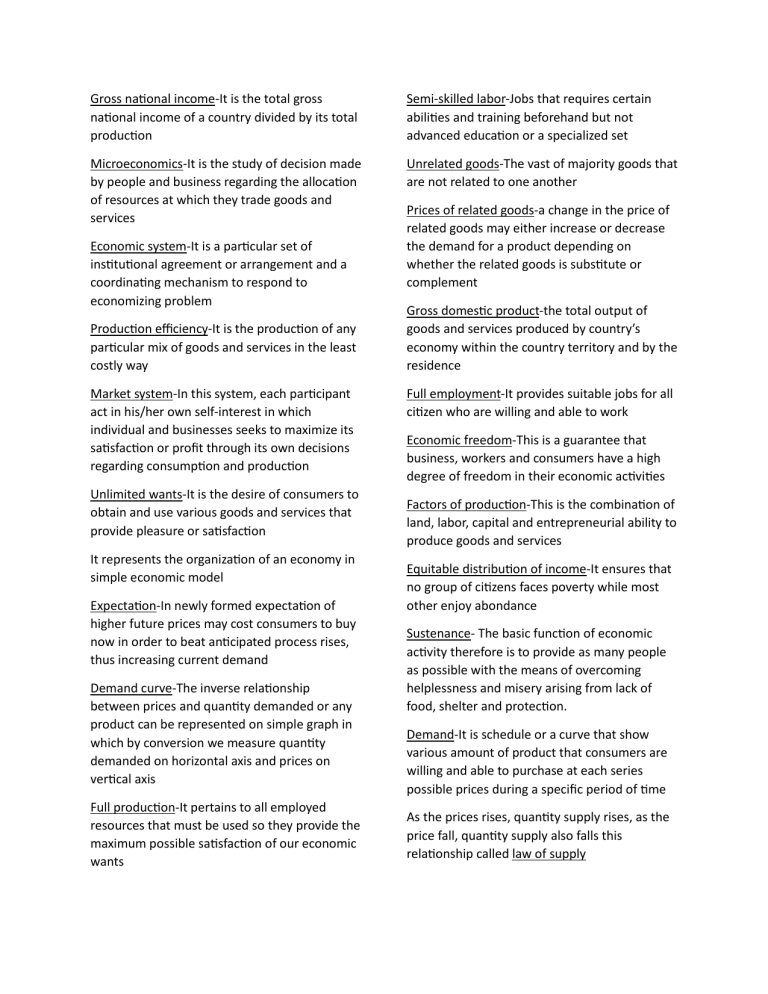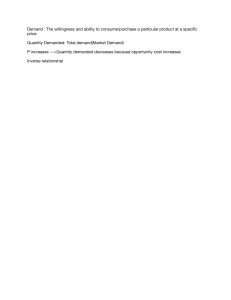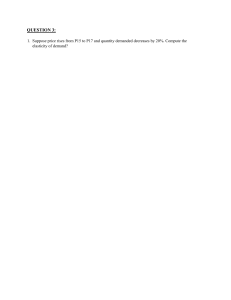
Gross national income-It is the total gross national income of a country divided by its total production Semi-skilled labor-Jobs that requires certain abilities and training beforehand but not advanced education or a specialized set Microeconomics-It is the study of decision made by people and business regarding the allocation of resources at which they trade goods and services Unrelated goods-The vast of majority goods that are not related to one another Economic system-It is a particular set of institutional agreement or arrangement and a coordinating mechanism to respond to economizing problem Production efficiency-It is the production of any particular mix of goods and services in the least costly way Market system-In this system, each participant act in his/her own self-interest in which individual and businesses seeks to maximize its satisfaction or profit through its own decisions regarding consumption and production Unlimited wants-It is the desire of consumers to obtain and use various goods and services that provide pleasure or satisfaction It represents the organization of an economy in simple economic model Expectation-In newly formed expectation of higher future prices may cost consumers to buy now in order to beat anticipated process rises, thus increasing current demand Demand curve-The inverse relationship between prices and quantity demanded or any product can be represented on simple graph in which by conversion we measure quantity demanded on horizontal axis and prices on vertical axis Full production-It pertains to all employed resources that must be used so they provide the maximum possible satisfaction of our economic wants Prices of related goods-a change in the price of related goods may either increase or decrease the demand for a product depending on whether the related goods is substitute or complement Gross domestic product-the total output of goods and services produced by country’s economy within the country territory and by the residence Full employment-It provides suitable jobs for all citizen who are willing and able to work Economic freedom-This is a guarantee that business, workers and consumers have a high degree of freedom in their economic activities Factors of production-This is the combination of land, labor, capital and entrepreneurial ability to produce goods and services Equitable distribution of income-It ensures that no group of citizens faces poverty while most other enjoy abondance Sustenance- The basic function of economic activity therefore is to provide as many people as possible with the means of overcoming helplessness and misery arising from lack of food, shelter and protection. Demand-It is schedule or a curve that show various amount of product that consumers are willing and able to purchase at each series possible prices during a specific period of time As the prices rises, quantity supply rises, as the price fall, quantity supply also falls this relationship called law of supply Supply – is a schedule or curve showing the amounts of a product that producers are willing and able to make available for sale at each of a series of possible prices during a specific period. Demand – is a schedule or a curve that shows the various amount of a product that consumers are willing and able to purchase at each of a series of possible prices during a specific period of time. Change in demand- A change in the demand schedule or, graphically, a shift in the demand curve Taxes and Subsidies – Business treat most taxes as costs. An increase in sales or property taxes will increase production costs and reduce supply. Superior goods, or normal goods- Products whose demands varies directly with money income Inferior goods-Goods whose demand varies inversely with money income Economic Development is the development of economic wealth of countries or regions for wellbeing of their habitants. Traditional economics is concerned primarily with the efficient, least-cost allocation of scarce productive resources Self-Esteem- A second universal component of the good life Freedom from Servitude- A third and final universal value that we suggest should constitute the meaning of development is the concept of human freedom. Economic policies are designed to achieve certain economic goals, Economic growth – produce more and better goods and services, or more simply, develop a higher standard of living. Economic efficiency – achieve the maximum fulfillment of wants using the available productive resources. Pure capitalism – or laissez-faire capitalism --“laissez-faire” means “let it be,” Price-level stability – Avoid large upswings and downswings in the general price level; that is avoid inflation and deflation Economic security – Provide for those who are chronically ill, disabled, laid off, aged, or otherwise unable to earn minimal levels of income. Balance of trade – Seek a reasonable overall balance with the rest of the world in international trade and financial transactions. ECONOMICS – is the study of scarcity and its implications for the use of resources, production of goods and services, growth of production and welfare over time Demand, Supply and Equilibrium: Prices are determined by the law of supply and demand. In a perfectly competitive market, suppliers offer the same price demanded by consumers. This creates economic equilibrium. Economic development- is concerned with the impact of policies and programs on the country’s productive potential human resource development, resource allocation, quality of life and sectoral growth. Capital- includes all manufactured aids used in producing consumer goods and services. Production Theory: This principle is the study of how goods and services are created or manufactured. Costs of Production: According to this theory, the price of goods or services is determined by the cost of the resources used during production. Labor Economics: This principle looks at workers and employers, and tries to understand patterns of wages, employment, and income. Macroeconomics is concerned with economywide factors such as inflation, unemployment, and overall economic growth basically this Macroeconomics looks at the decisions of countries and governments. Society’s economic wants – that is, the economic wants of its citizens and institutionsare virtually unlimited and insatiable. Scarce Resources – The second fundamental fact is that economic resources are limited or scarce. Entrepreneurial Ability – there is the special human resource, distinct from labor Command System- also known as socialism or communism. Government owns most property resources and economic decision making occurs through a central economic plan. circular flow diagram. Resources flow from households to business through the resource market, and products flow from the business to the households through the product market. QUANTITY DEMANDED FORMULA: Qd=x-Yp Quantity Supply: Qs = x + yP






